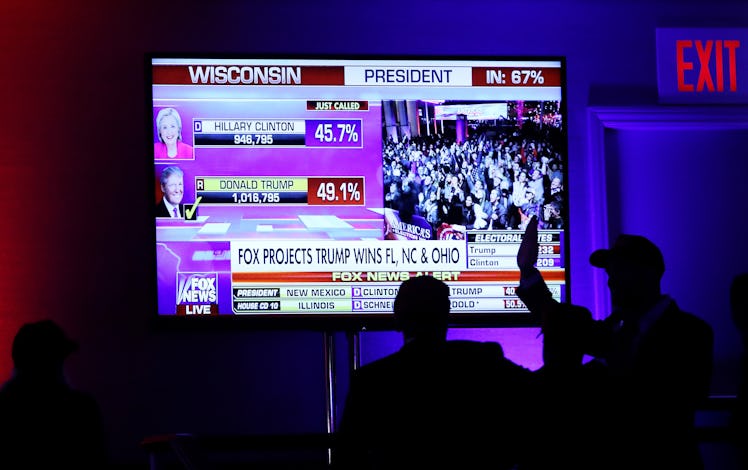
These 3 "Too Close To Call" States Have 1 Big Thing In Common
Just hours after prematurely claiming victory on Wednesday, Nov. 4, President Donald Trump headed to Twitter with three states on his radar: Pennsylvania, Michigan, and Wisconsin. While all three states were originally trending red on election night, the gap began narrowing as early and mail-in ballots were counted on Nov. 4 — and President Trump was quick to baselessly declare that voter fraud was at work at driving those results. Despite the president's claims, however, the results might not be that surprising as these states not called yet in 2020 as of Nov. 4 at 12:30 p.m. ET all have one major thing in common.
All eyes were on a few states on Nov. 4 — Pennsylvania, Michigan and Wisconsin — still counting mail-in ballots. These same states were also hotly contested four years ago, and while President Trump did win the three states in 2016 while running against Hillary Clinton, the margins of victory were very slim.
Four years ago, President Trump won Pennsylvania by just 44,292 votes out of more than 6 million cast in the state, and the margin of 0.72% was the narrowest the state had experiences in a presidential election in 176 years. His lead was even narrower in Michigan, which he won by 10,704 votes, a margin of 0.23%. Meanwhile, in Wisconsin, the president won by 22,748 votes, which was a margin of 0.77%. In short, the president was able to clinch 46 electoral votes from the three states, and thus the presidency, by winning a total of just 77,744 more votes than Clinton in those three states.
As the votes were counted on the morning of Nov. 4, the margins again were thin in the three states. According to The New York Times tracker as of 2 p.m. ET, Biden held a less than 1% lead in Wisconsin, with more than 98% of the vote reported, as well as .9% lead in Michigan with 94% of the vote reported there. Pennsylvania has the lowest vote reporting percentage (80%) as more mail-in ballots were counted, and Trump held an 8.1% lead there, but it was expected to drop as more mail-in ballots were counted.
In the end, all three states were called for Biden. According to The New York Times as of Nov. 9 at 10:30 a.m. ET, in Wisconsin, Biden took 49.5% of the vote over Trump's 48.8%. Biden took 50.5% of the vote in Michigan over Trump's 47.9%, and Biden took 49.7% in Pennsylvania over Trump's 49%.
During a race which saw record early voting (over 100 million people just voted early compared to the total 139 million people who voted during the 2016 presidential election) due to the ongoing coronavirus pandemic, news outlets warned that the typical projections calculated by precincts reporting might not be as accurate this year due to a "red mirage," which would appear to show Trump winning early on in the night. As mail-in ballots were added in, Trump's lead began to dwindle.
In response, the president prematurely claimed he'd won the election and took to Twitter on Nov. 4 to claim, without evidence, that voter fraud must be at work. In addition to calling mail-in ballots "surprise" votes, he referred to counting ballots that had been cast as "finding" ballots in messages that were later marked by Twitter as containing inaccurate or misleading information.
"Last night I was leading, often solidly, in many key States, in almost all instances Democrat run & controlled. Then, one by one, they started to magically disappear as surprise ballot dumps were counted," he tweeted. "VERY STRANGE, and the 'pollsters' got it completely & historically wrong!" Twitter later marked this tweet has having misleading information.
Trump added in a later tweet, "They are finding Biden votes all over the place — in Pennsylvania, Wisconsin, and Michigan. So bad for our Country!"
In addition to calling mail-in ballots fraudulent, which is a claim that has been disputed, Trump said in his Nov. 4 speech that he was willing to go to the Supreme Court to help stop the counting of ballots after Nov. 3.
"We want the law to be used in a proper manner. So we’ll be going to the U.S. Supreme Court. We want all voting to stop. We don’t want them to find any ballots at 4 [a.m.] and add them to the list." Elite Daily previously reached out to the Trump campaign for clarification on his comments and to see if the president was referring to halting the count of mail-in ballots in certain states, but did not hear back at the time of publication.
Editor's Note: This story has been updated to reflect the projected results in the 2020 election.
This article was originally published on